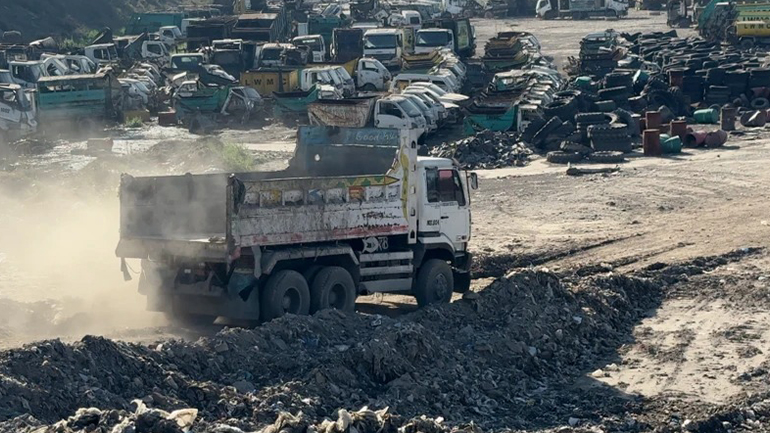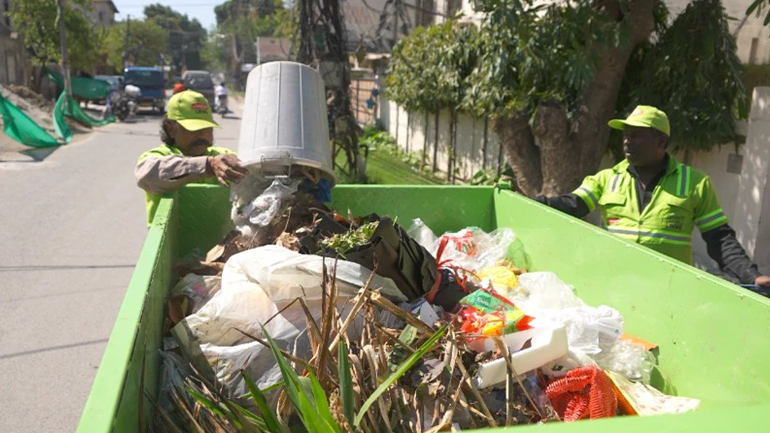

A while ago, while traveling on the Ring Road in the suburbs of Lahore, Pakistan's second-largest city, I encountered a particular spot where a strong stench from afar indicated that I was passing through the Mahmood Buti Landfill, a major site of garbage pollution. This odor emanated from the landfill site in Mahmood Buti where a mountain of garbage had reached nearly 80 feet in height. Over the years, this landfill had accumulated approximately 14 million tons of waste from Lahore’s dumping sites, spreading across nearly 41 acres. However, the foul smell and the unsightly view were not the biggest concerns. The major issue was the emission of a dangerous, odorless gas—methane gas emissions—which significantly contributes to the climate change impact. Methane has a significantly higher potential to contribute to air pollution in Lahore compared to carbon dioxide. Over 20 years, methane has 80% more capacity to warm the planet compared to carbon dioxide. As soon as methane molecules enter the atmosphere, they immediately trap heat. Although methane has a shorter lifespan in the atmosphere compared to carbon dioxide, during its presence, it plays a much more significant role in global warming. In 2021 and the following years, various satellite observations detected a methane cloud over Lahore. Specifically, one such cloud was observed over the Mahmood Buti Landfill and the nearby Lakhu Dair Dump Site. The presence of this cloud, formed by landfill gas emissions, highlighted the severity of the environmental threat posed by unmanaged waste disposal in the city. Speaking to Lahore Waste Management Company’s CEO, Babar Sahib Deen, he mentioned that, according to a Bloomberg report, in 2021, a methane bubble was detected over this landfill site, which became a significant issue. The report stated that the observed methane cloud had an emission rate of approximately 126 metric tons per hour. According to the International Energy Agency, in 2021, Pakistan was the seventh-largest emitter of methane in the world. Besides methane polluting the air, the Mahmood Buti Dump Site was also contaminating groundwater with leachate formation, making it unfit for consumption. Years of accumulated waste, combined with rainwater and favorable temperatures, created an ideal environment for the formation of toxic leachate, a liquid produced by waste decomposition. This led to groundwater contamination, posing serious public health concerns for the residents relying on underground water sources. According to LWMC CEO Babar Sahib Deen, “When rainwater mixes with this leachate, it seeps underground and pollutes the water supply.” This not only affected drinking water quality but also raised alarms about environmental hazards associated with waste mismanagement. However, in recent months, the 14 million tons of waste at the Mahmood Buti Dump Site have gradually disappeared. The stench is gone, and instead of a garbage mountain, a mound of soil now stands in its place. This transformation is part of ongoing efforts toward sustainable waste disposal and waste management solutions, aiming to curb pollution, mitigate climate effects, and promote a cleaner Lahore.
The Punjab government, and particularly the authorities responsible for waste disposal and garbage management, have been struggling with this issue. In 2016, the Mahmood Buti Landfill Site was officially closed, marking the beginning of a landfill transformation effort. However, the bigger challenge remained—what to do with such a massive amount of solid waste and how to implement sustainable waste solutions? The methane gas emissions released into Lahore’s air had the potential to cause immediate temperature changes in the surrounding area, thereby altering local weather conditions. This posed a significant challenge to environmental cleanup efforts and increased concerns about the urban waste crisis. During smog season, which brings extreme air pollution in Lahore, the intensity of smog was observed to be significantly higher around this area along the Ring Road. The lingering waste and its byproducts made Lahore sanitation a growing concern. Additionally, Pakistan, along with other countries, committed at the United Nations Climate Change Conference (COP 26) to reduce methane gas emissions from human activities by 30% by the year 2030. This aligns with global efforts toward eco-friendly waste disposal and reducing the impact of landfill gas emissions. Two major human sources of methane are livestock waste and landfill gas emissions. The government tried several strategies to control methane emissions from the Mahmood Buti Landfill but with little success. The primary challenge was the high costs associated with implementing effective waste-to-energy solutions and large-scale recycling and waste processing. Recently, the Lahore Waste Management Company (LWMC), in collaboration with the Ravi Urban Development Authority, launched a new project aimed at the dump site rehabilitation and land reclamation of the Mahmood Buti Landfill. As part of the initial phase of this Lahore Clean-Up Project, the 14 million tons of waste at the site have been covered under layers of soil, significantly contributing to waste reduction. Private companies have been tasked with executing this project, which is expected to be completed by August this year. The estimated cost of the project is approximately 1,400 million rupees, making it a critical step toward sustainable waste solutions and solid waste management in Lahore.

LWMC CEO Babar Sahib Deen stated that under this project, gas will be extracted from the 41-acre landfill site and sold to nearby industries as part of a waste-to-energy solution, reducing reliance on public sector investment for energy production. “In addition, an 11-acre solar park will be established, capable of generating approximately five megawatts of electricity, contributing to national budget planning for renewable energy. The remaining 30 acres will be used for the development of an urban forest, supporting land reclamation and sustainable waste solutions through development funds.” Significant progress has already been made on leveling and grading at the Mahmood Buti site. Leachate extraction has also been carried out through drilling, and vent pipes have been installed to manage methane gas emissions, demonstrating the economic feasibility of landfill rehabilitation. Instead of forming large methane clouds, the gas is now being released gradually through these vents. Babar Sahib Deen mentioned that a survey is currently underway to assess the volume of gas available. Once the assessment is complete, the process of gas extraction will begin, potentially reducing dependency on foreign aid and loans for waste management projects. “If a significant amount of gas is available, it will be supplied to nearby industries, promoting public-private partnerships for sustainable energy. However, if the quantity is insufficient, it will be burned off to prevent air pollution,” he added. A key question remains—why didn’t the government undertake this project years ago? If the costs were too high back then, where is the funding coming from now for such a large-scale landfill transformation? Babar Sahib Deen clarified, “The best part of this project is that it will not cost the government a single penny, eliminating the need for state financial resources or tax revenue utilization.” He explained that the entire investment is being made by private companies, which will be compensated through carbon credits, a financial mechanism that rewards eco-friendly waste disposal and environmental cleanup efforts without relying on government funding sources.

Carbon Credits can also be described as a certified reduction in greenhouse gas emissions. When a company, individual, or organization undertakes a project that reduces or eliminates greenhouse gas emissions, it generates carbon credits. For every metric ton of greenhouse gas emissions reduced or eliminated, one carbon credit is created. These credits can then be sold in the carbon market, where companies that are unable to reduce their emissions purchase them to offset their carbon footprint. This effectively funds environmental cleanup projects that contribute to emission reductions, allowing the purchasing companies to balance out their carbon emissions with the certified elimination of greenhouse gases. There are two types of carbon markets: one is government-regulated, while the other operates voluntarily. The value of carbon credits depends on project quality and market conditions.
Carbon credits are awarded for reducing various types of greenhouse gas emissions, including those from waste management solutions, waste-to-energy projects, technological advancements, renewable energy initiatives, and nature-based carbon reduction methods. Before a project qualifies for carbon credits, it undergoes strict third-party verification to ensure it genuinely reduces or eliminates greenhouse gas emissions. The evaluation also determines how much carbon reduction the project can achieve, which directly influences the value of its carbon credits. LWMC CEO Babar Sahib Deen explained that in the carbon market, the price of a single carbon credit varies between $5 and $50, depending on project quality. “As our project focuses on waste management, we expect to sell each carbon credit for around $18 to $20,” he stated. A detailed feasibility study is currently underway and expected to be completed in three months. However, projections suggest that within one year, this project could generate between $500,000 and $1 million through carbon credit sales. Once the Mahmood Buti Landfill rehabilitation is complete, additional revenue will be generated from both the solar park and methane gas extraction, with LWMC receiving a share to support its efforts in keeping Lahore clean.
Methane emissions have two major sources: livestock waste and poorly managed landfill sites. The mismanagement of landfills contributes significantly to the release of methane, a potent greenhouse gas that accelerates climate change. It remains to be seen whether the government can fully implement the Mahmood Buti Landfill rehabilitation project. Even if it succeeds, Mahmood Buti is not the only landfill site containing millions of tons of waste. Since the closure of Mahmood Buti, most of Lahore’s waste has been redirected to the Lakhodair Landfill Site, located nearby. Every day, approximately 5,000 tons of garbage is dumped there. Over time, millions of tons of waste have accumulated, and the site now spans several acres. Lakhodair is also a significant source of methane emissions, contributing to urban pollution and environmental degradation. Similarly, numerous landfill sites exist throughout Punjab, all posing serious environmental threats. LWMC CEO Babar Sahib Deen told them that the government plans to rehabilitate the Lakhodair Landfill using a similar approach to Mahmood Buti. “The German government has provided funding for the feasibility study, and work is already in progress. Methane gas from Lakhodair will also be extracted and supplied to nearby industries,” he explained. In the future, an urban forest and a solar park will also be established at Lakhodair, following the Mahmood Buti model. Babar Sahib Deen noted that landfill site rehabilitation was once a costly challenge, making large-scale projects financially unfeasible. However, carbon credits now offer a sustainable funding solution, making it possible to replicate such projects in other locations.
Powered by Froala Editor